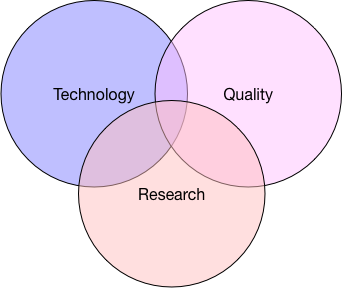Creative 1/3: Next generation electronic health records
In “Where is the value?”, I talked about market disruption by the cycle of commoditisation and creative destruction.
Soon, there will be a period of creative destruction for the healthcare information technology industry resulting from four important drivers:
- The recognition that software and data are critical enablers of clinical quality improvement, service transformation and advancing our knowledge.
- That to support quality improvement, we will adopt practices used in the most highly productive technology companies to permit the supporting software to be developed, tested and deployed rapidly, iteratively, safely and securely. At the same time, we will increasingly see the benefits from building smaller self-contained components via small cross-functional teams with bounded contexts and loose coupling with other components. In essence, we will adopt software quality improvement methodologies in our development processes to drive clinical quality improvement. Adoption of these approaches will result in changes to our culture, our enterprise architecture and drive the use of standards.
- That complex, adaptive environments such as healthcare benefit from a domain-driven approach and separation of the storage / transmission of data from software functions that operate upon those data. Our adoption of shared data standards is critical to this; essentially this means a shared language used within bounded but shared interdisciplinary contexts. Separation of software functionality from the way those data are persisted is essential in building software systems for cultures that recognise our work will never be complete and we will always strive to improve.
- That software-as-a-service is becoming commonplace; as a result, we will increasingly blend functionality from in-house teams with that provided by multiple other service providers. In essence, many computing functions will become commoditised and others will become specialist and pay-per-use; almost all will be provided by commodity cloud providers and infrastructure-as-a-service. As a result, we will adopt an ecosystem of compute functions operating upon data stored or transmitted independently; monolithic applications will be quickly overtaken by blended applications stitching together software functionality from multiple vendors to create increasing value for end-users.
My next blog posts will take each of these in turn and explore the best way for us all, whether health providers or software companies, to take advantage of the changes that new technology can bring. I truly believe that this must inform how we build the next generation of electronic health record software: distributed, cloud-based and centred on the patient and not the organisation.

We need to recognise the overlap and mutually dependent relationships between:
- our efforts in healthcare service transformation and quality improvement
- research and advancing our knowledge
- technology and digital tools
Understanding these relationships, and the fact that software is truly a transformative force for good, is critical for those of us who want to support healthcare with technology.
Continue reading… part two covers the importance of software in our efforts to transform clinical services and improve quality.
Mark
Posts in this series
- Part one: creative destruction
- Part two: the value of software for healthcare
- Part three: ecosystems and the platform